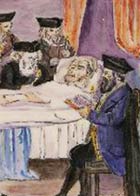Holy Societies

In the Hebrew calendar, Sunday February 21 is the seventh day of Adar, the date traditionally marking the death of Moses on Mount Nebo, overlooking Canaan, alone with God.
The Lord's personal oversight of Moses' interment, in a place "unknown to this day" (Deuteronomy 34:6), inspired the rabbis of the Talmud to praise the act of burying the dead with dignity as an expression of true (because unrecompensed) kindness and indeed of imitatio dei, the injunction to follow God's ways. So it is that the seventh day of Adar is designated by tradition to honor the institution of the Hevra Kadisha, the "holy society" whose members see to it that the dead are appropriately "purified" by being washed, clothed in shrouds, and bidden farewell with prayers and blessings.
While various Jewish burial practices date to antiquity, "holy societies" first took shape in the Middle Ages, but they did not assume organized form until the 17th century. Thanks in part to the growing influence of Kabbalah, Jews sought to turn the experiences of death and deathbed repentance—and, they hoped, eventual resurrection—into occasions for deeper union with God. This effort to spiritualize mortality would subsequently give way as modernity began increasingly to move the experience of death from the home and community to the institutionalized settings we know today. In the New World, the hevra kadisha, along with landsmanshaftn, served for a time as a means of keeping touch with an earlier, more intimate identity.
In our own age, many holy societies have fallen on hard times. In Israel they are mostly the province of the ultra-Orthodox; an offshoot, Zaka, has created a unique fusion between the religious and the military ethos. By contrast, for some American Jews today, the hevra kadisha has come to exercise a renewed appeal as a meaningful mode of confronting the experience of death and mourning with an insistence on the divine image inscribed in the human person until the last.
Comments are closed for this article.




